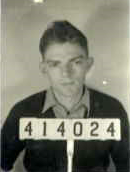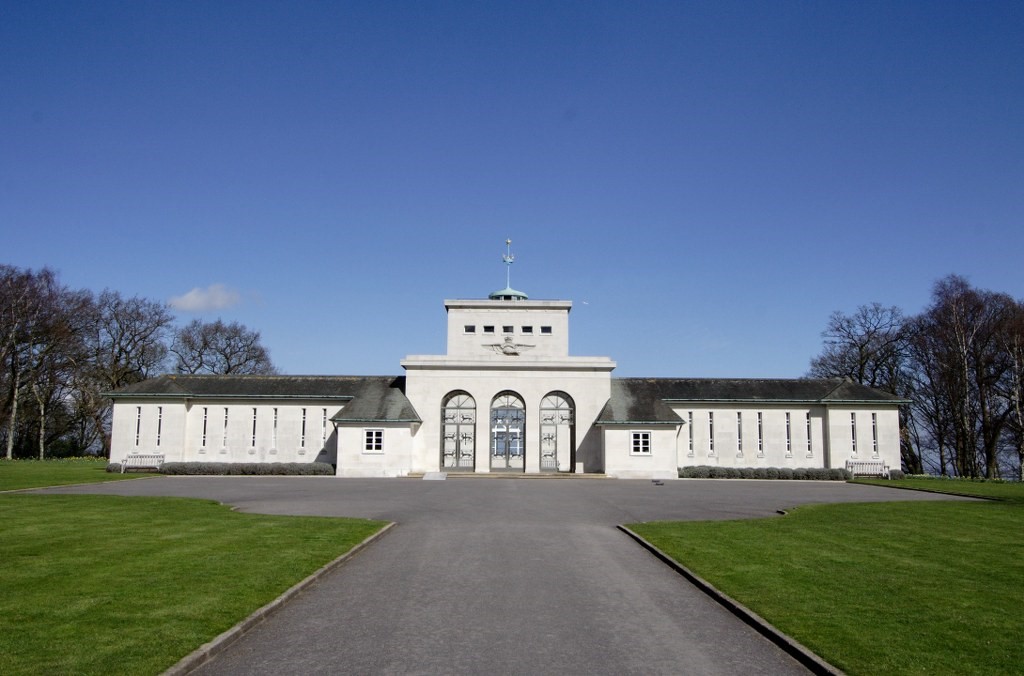Pilot Officer Hector William Harris, the son of William Henry Harris and Bessie Florence Harris, was born at Brisbane in Queensland on 10th July 1920. He was educated at the Oakey State School and later attended the Toowoomba Grammar School. Whilst a student at Grammar, he served for two years in the Cadet Corps with the rank of Private. After leaving school he entered employment as a Bank Clerk with the Bank of New South Wales at Proserpine in Queensland. He was enrolled in the Reserve of the Royal Australian Air Force on 27th September 1940 after swearing the statutory oath of allegiance. At the age of 21 years he was enlisted into the Citizen Air Force of the R.A.A.F. at No. 3 Recruiting Centre in Brisbane on 20th July 1941 after giving a commitment that he would serve for the duration of the war and an additional twelve months. He had previously served for 3 months as a Private in the Citizen Military Forces with the 47th Infantry Battalion. His physical description was that he was 5 feet 11 inches in height and weighed 146 pounds. He had a fair complexion, hazel eyes and light brown hair. He stated that he was of the Church of England religion. He gave his next of kin as his father, Mr William Henry Harris, c/- State School, Manly, Queensland.
Pilot Officer Hector Harris was allotted the service number of 414024. He joined No. 3 Initial Training School at Amberley in Queensland on 20th July 1941 where he was trained in military discipline and the basics of military aviation. He was selected to train as an Air Observer. He joined No. 2 Embarkation Depot at Bradfield Park in Sydney on 31st January 1942. He then attended No. 1 Air Observer School at Cootamundra in New South Wales on 2nd March 1942. He then proceeded to No. 1 Bombing & Gunnery School at Evans Head in New South Wales on 1st June 1942. He joined No. 1 Air Navigation School at Parkes in New South Wales on 25th July 1942. Upon completing his training at Parkes he was remustered as an Air Observer and promoted to the rank of Temporary Sergeant on 20th August 1942. He joined No. 3 Embarkation Depot at Sandgate in Queensland on 3rd September 1942 prior to being granted pre-embarkation leave. He joined No. 2 Embarkation Depot at Bradfield Park in New South Wales on 10th September 1942 to prepare for movement overseas on attachment to the Royal Air Force.
Pilot Officer Hector Harris embarked from Sydney in New South Wales on 18th September 1942 and disembarked in England on 15th January 1943 where he joined No. 11 Personnel Despatch & Reception Centre at Bournemouth later that day. He was promoted to the rank of Temporary Flight Sergeant on 20th February 1943. He joined No. 14 Operational Training Unit at Royal Air Force Station Cottesmore on 20th April 1943 where he was trained for night bombing. After he completed his training at Cottesmore he was remustered as a Navigator on 14th July 1943 and awarded the Air Observer Qualification Badge on 17th July 1943. He joined No. 1654 Conversion Unit at Royal Air Force Station Wigsley on 14th July 1943. He joined No. 61 Squadron Royal Air Force at Royal Air Force Station Skellingthorpe for operational duty on 19th August 1943. He was commissioned as a Pilot Officer on 14th October 1943.
Pilot Officer Hector Harris was the Navigator and crew member of a No. 61 Squadron Royal Air Force Lancaster bomber DV 339 that was lost as a result of enemy action whilst attacking Berlin in Germany on 26th November 1943. Hector Harris’ father, Major W.H. Harris, who was serving in the Australian Imperial Force with the 31st/51st Infantry Battalion in New Guinea, was notified by telegram on 9th December that his son was missing as a result of air operations. The Commanding Officer of No. 61 Squadron wrote the following letter to Major Harris on 3rd December 1943:
Dear Major Harris, It is with the deepest regret that I have to confirm the sad news, which you will have received by cable, that your son, Pilot Officer H.W. Harris, is missing with all his crew from air operations on the night of 26th/27th November 1943. He was detailed to attack Berlin on that night, and, after the aircraft left this station nothing more was heard of it. This, in itself, is not necessarily final, as wireless silence has to be maintained on operations to prevent the enemy from easily ascertaining the position and intentions of our aircraft. There is, therefore, every reasonable hope that he and his crew may have escaped by parachute, as so many others have done, in which case there should be good news of them. This news usually takes about six weeks to two months to come through, though the International Red Cross do all that is possible to hasten news of prisoners-of-war. We must therefore hope and pray that there may soon be good news of your son and his crew. Your son had only just been commissioned, and we were confidently expecting great things from him. He is a highly skilled Navigator, and this was his fourteenth sortie, all the others having been highly successful. His loss is a great blow to the squadron. We all have the highest admiration and affection for the fine young men of Australia who have come so far, and left so much behind them, to join us in this great cause. The deep sympathy of all members of this squadron is with you in this anxious time of waiting which, we earnestly hope, will soon be happily terminated by good news. Yours sincerely, Squadron Leader.
The Commanding Officer of No. 61 Squadron sent the following report to the Air Ministry on 4th December 1943:
I have the honour to submit the following report: Lancaster DV 339 left Skellingthorpe Airfield at 1721 hours on 26th November 1943 on bombing operations at Berlin. Since its departure no communications have been received from the aircraft, which together with all members of its crew has been reported missing as from 26th November 1943. Pilots of other aircraft from this unit engaged on similar operations report clear visibility, no cloud, slight ground haze. Fighters were met on route also on the return journey. In the target area there was a considerable amount of searchlight activity, and heavy flak. Fires were well concentrated and seen a considerable distance away. No observations were made by anyone that could have reasonably been connected with the non-return of Lancaster DV 339.
Pilot Officer Hector Harris’ father was subsequently notified on 7th February 1944 that information received by the International Red Cross Committee in Geneva revealed that Hector Harris and the remainder of the Lancaster’s crew had lost his lives.
Extensive searches were made by the Missing Research & Enquiry Service in the years after the war to locate the remains of missing airmen. The Secretary, Department of Air, Melbourne, sent the following letter to Hector Harris’ father on 10th November 1949:
Dear Sir, It is with great regret that I refer again to your late son, Pilot Officer Hector William Harris. The Missing Research & Enquiry Service has made prolonged and thorough investigations in the endeavour to ascertain the details of the manner in which your son lost his life and to recover his body for burial, but, unfortunately, no news of the aircraft or any member of the crew could be obtained. In view of the complete absence of any information it is now considered unlikely that any further news will be obtained. Your son will be commemorated by including his name on a memorial to be erected on the banks of the Thames at Runnymede by the Imperial War Graves Commission, in memory of all those members of the United Kingdom and Dominion Air Forces who lost their lives in North Western Europe, and who have no known grave. It is thought that you would like to know that every effort had been made to obtain some definite information for you. May I assure you of the constant sympathy of this Department and of all those who have been concerned in this investigation. Yours faithfully, M.C. Langslow. Secretary.
Pilot Officer Hector Harris, at the time of his death was 23 years of age. His name is commemorated on the Runnymede Memorial to the missing. His name is commemorated on Panel No. 123 at the Australian War Memorial in Canberra and locally on the Toowoomba Grammar School World War 2 Honour Board. For his service during World War 2, he had entitlement for the Air Observer Qualification Badge, the 1939/1945 Star, the Aircrew Europe Star, the Defence Medal, the War Medal and the Australian Service Medal 1939/1945.
Note
No. 61 Squadron Royal Air Force lost three Lancasters and 21 crew killed on the raid in which Hector Harris lost his life.
A comprehensive account of the raid is contained in Chapter 4 of Alan W. Cooper’s publication, “Bombers Over Berlin – The R.A.F. Offensive”. Pen & Sword Aviation. 1985. South Yorkshire. ISBN 978 1 78159 065 2.
Toowoomba Grammar School archive records show that he was enrolled as a day student on 30th January 1934 and that he left the School on 6th December 1935 after completing the Junior examination in which he passed nine subjects. His parent was shown as Mr W.H. Harris, Teacher, Oakey.




